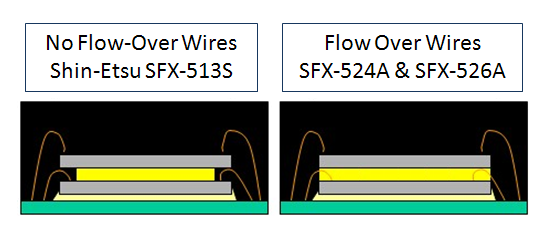In the last post about Same Size Die Stacking Options, we discussed the various ways to do same size die stacking of die, a typical configuration for memory die stacks that have the same dimensions. In this post, we would like to elaborate on the Wafer Backside Coating (WBC) options for same-size die stacks.
As can be seen in the photo below, there are also two variations on the Wafer Backside Coating Options also. The first figure on the left, there is the “no flow over wires” option. In this option, using Shin-Etsu SFX-513S the entire backside of the die is not coated and the wirebonding is either not affected during placement of the 2nd die, or the wirebonding is done in a subsequent stage in the process. In the second image on the right, using either Shin-Etsu SFX-524A Shin-Etsu SFX-526Aor the Wafer Backside Coating material does flow over the wires, and therefore needs to be liquid enough to pass over the wires during die placement and not cause any wire damage.

Advantages of No Flow Over Wire (NFOW) Technique:
- Epoxy Molding Compound (EMC) completely encapsulates the wire with no risk of Coefficient of Thermal Expansion (CTE) mismatch between Die Attach (DA) and EMC
- Die Attach Operation can be done separately from Wirebonding
Disadvantages of No Flow Over Wire (NFOW) Technique:
- A non-uniform wafer backside coating is applied to each die — requiring stencil application
Advantages of Flow Over Wire (FOW) Technique:
- A uniform wafer backside coating is applied to each die, stencil printing or spin-coating is possible
- Entire Wafer can be coated
- In-line process of die-attach, wirebonding, die-attach, wirebonding is preserved
Disadvantages of Flow Over Wire (FOW) Technique:
- Epoxy Molding Compound (EMC) does not completely encapsulates the wire, so there is a risk of Coefficient of Thermal Expansion (CTE) mismatch between Die Attach (DA) and EMC
- Die Attach Operation can be done separately from Wirebonding
The difference between Shin-Etsu SFX-524A and Shin-Etsu SFX-526A is that Shin-Etsu SFX-524A contains no solvent and is therefore better suited for spin-coating, wheareas Shin-Etsu SFX-526A has solvent which helps it hold its shape better after stencil printing.
For more information regarding Shin-Etsu Die Attach SFX-513S, Shin-Etsu SFX-524A or Shin-Etsu SFX-526A please visit us or contact us for more details.


Dicing Die-Attach Films (DDAF) are in my opinion the future of this market. The biggest challenge with this product as I see it is that no single company possesses a long history and experience with the production of such a product. These products are the result of a combination of die-attach chemistry and wafer dicing film capabilities.